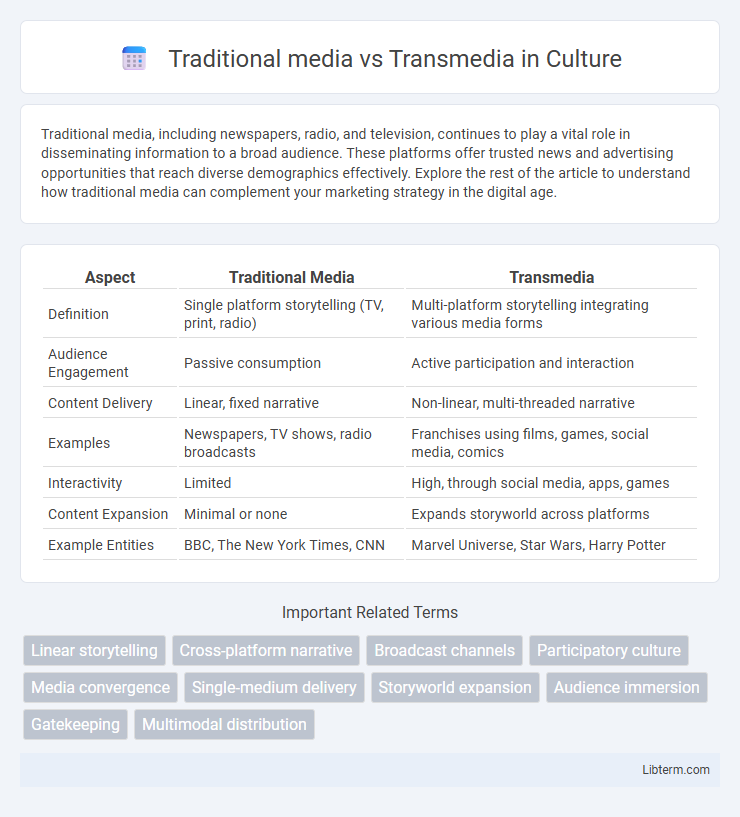Traditional media, including newspapers, radio, and television, continues to play a vital role in disseminating information to a broad audience. These platforms offer trusted news and advertising opportunities that reach diverse demographics effectively. Explore the rest of the article to understand how traditional media can complement your marketing strategy in the digital age.
Table of Comparison
| Aspect | Traditional Media | Transmedia |
|---|---|---|
| Definition | Single platform storytelling (TV, print, radio) | Multi-platform storytelling integrating various media forms |
| Audience Engagement | Passive consumption | Active participation and interaction |
| Content Delivery | Linear, fixed narrative | Non-linear, multi-threaded narrative |
| Examples | Newspapers, TV shows, radio broadcasts | Franchises using films, games, social media, comics |
| Interactivity | Limited | High, through social media, apps, games |
| Content Expansion | Minimal or none | Expands storyworld across platforms |
| Example Entities | BBC, The New York Times, CNN | Marvel Universe, Star Wars, Harry Potter |
Defining Traditional Media
Traditional media encompasses established communication channels such as television, radio, newspapers, and magazines that distribute content through a one-way, linear format. These platforms primarily offer static, uniform messages designed for broad audiences without interactive engagement. Characterized by fixed scheduling and physical or broadcast delivery, traditional media contrasts with the dynamic, multi-platform storytelling methods of transmedia.
What is Transmedia?
Transmedia is a storytelling technique that unfolds a narrative across multiple platforms and formats, such as books, films, games, and social media, creating an immersive and interactive experience. Unlike traditional media, which delivers content through a single channel, transmedia leverages each platform's unique strengths to expand the story world and engage audiences on various levels. This strategic use of diverse media enhances audience participation and deepens emotional connections with the narrative.
Key Differences Between Traditional and Transmedia
Traditional media relies on a single platform such as television, radio, or print to deliver a linear and static narrative to a passive audience. Transmedia storytelling integrates multiple digital and physical platforms, allowing users to engage interactively and experience a fragmented narrative that unfolds across various media channels. Key differences include audience participation levels, narrative complexity, and the use of diverse media formats to create a more immersive and cohesive storytelling experience.
Evolution of Audience Engagement
Traditional media primarily delivers a one-way communication flow where audience engagement is limited to passive consumption, such as watching television or reading newspapers. Transmedia storytelling revolutionizes this dynamic by integrating multiple platforms--like films, social media, video games, and websites--enabling active participation and immersive experiences that deepen audience involvement. The evolution from passive reception to interactive collaboration reflects a significant shift in how audiences connect with and influence content across diverse media ecosystems.
Storytelling Approaches: Linear vs. Multiplatform
Traditional media employs a linear storytelling approach, presenting narratives in a fixed sequence through singular channels such as television, radio, or print. Transmedia storytelling uses a multiplatform strategy, expanding narratives across various media formats like social media, games, and interactive websites to engage audiences in diverse ways. This approach enhances audience participation and creates a more immersive experience by allowing story elements to unfold simultaneously across multiple platforms.
Content Creation and Distribution Channels
Traditional media relies on singular content creation targeted to passive audiences through established distribution channels such as television, radio, and print, offering limited interactivity and fixed narrative structures. Transmedia content creation integrates multiple platforms--social media, websites, mobile apps--to deliver cohesive narratives that encourage active audience participation and nonlinear engagement. Distribution channels in transmedia are diverse and dynamic, leveraging digital ecosystems for real-time updates and immersive experiences that expand beyond traditional one-way communication.
Role of Technology in Media Transformation
Technology drives the shift from traditional media, which relies on single-platform content delivery, to transmedia storytelling that engages audiences across multiple digital platforms. Innovations like high-speed internet, mobile devices, and social media enable interactive and immersive experiences, enhancing audience participation and content distribution. This digital evolution transforms media consumption from passive reception to active engagement, expanding narrative possibilities and marketing strategies.
Impact on Brand Communication Strategies
Traditional media channels such as television, print, and radio deliver controlled, one-way brand messages that prioritize broad reach and consistency, shaping consumer perceptions through repetition and authoritative content. Transmedia storytelling leverages multiple interconnected platforms--social media, apps, video games, and VR--to create immersive, participatory brand experiences, fostering deeper emotional engagement and community building. Brands adopting transmedia strategies benefit from enhanced consumer interaction, real-time feedback, and the ability to tailor messages dynamically, significantly amplifying brand loyalty and advocacy in competitive markets.
Advantages and Challenges of Each Approach
Traditional media offers advantages such as controlled messaging, broad reach through established channels like television and print, and high credibility with established audiences, but faces challenges in limited interactivity and declining engagement in digital-first generations. Transmedia leverages multiple platforms to create immersive storytelling experiences, enhancing audience participation and fostering deeper brand loyalty; however, it requires complex coordination, significant resource investment, and risks message fragmentation across diverse media. Balancing the predictability and authority of traditional media with the dynamic, participatory nature of transmedia is crucial for maximizing impact in integrated marketing strategies.
Future Trends in Media Consumption
Traditional media, characterized by singular platforms like television and print, faces challenges in engaging audiences seeking immersive experiences. Transmedia storytelling integrates multiple platforms such as social media, gaming, and virtual reality to create interactive and cohesive narratives that enhance audience participation. Future trends indicate a rise in personalized content delivery and real-time engagement powered by AI and augmented reality, reshaping media consumption patterns toward more fragmented yet interconnected experiences.
Traditional media Infographic

 libterm.com
libterm.com